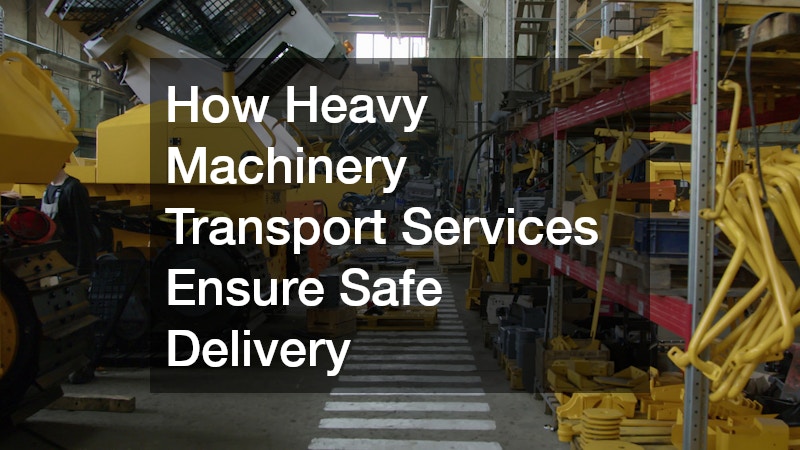Heavy Machinery Transport Services play a crucial role in Australia’s construction, mining and agricultural sectors. Moving large, expensive and complex equipment across long distances requires careful planning, specialised vehicles and expert coordination.
Whether transporting an excavator across the state or relocating a crane to a remote project site, the focus remains on safety, efficiency and compliance.
The process involves more than just loading and unloading. From assessing equipment dimensions to navigating permit regulations and securing cargo, each stage is essential for a successful and damage-free delivery.
Planning and Pre-Transport Assessment
Safe delivery starts long before a truck hits the road. Once a transport request is made, the company will conduct a thorough assessment of the machinery and the journey ahead. This includes measuring the height, width, weight and length of the load to determine the right trailer and route.
Oversized loads often require pilot vehicles, traffic escorts and approved travel times. Operators also check for road conditions, bridge clearances, construction zones and weather forecasts that might affect the trip. A pre-transport checklist ensures all parts of the machine are secure and prepared, such as folding mirrors or removing attachments to reduce the profile.
Route planning is one of the most critical stages. In some cases, roads may not be wide or strong enough to accommodate the load, which means seeking alternative access points or applying for road authority approval. These details are handled by the transport provider as part of their service.
Choosing the Right Equipment
Different machinery types require different transport solutions. Heavy Machinery Transport Services use a range of trailers, such as low-loaders, flatbeds, extendable trailers and floats. The choice depends on the machine’s size and mobility.
Low-loaders, for instance, are ideal for tall equipment because they sit closer to the ground and reduce overall load height. Extendable trailers are used when machines are too long for standard options. Hydraulic ramps and winches may be added to assist with safe loading and unloading.
In many cases, machinery cannot be driven onto a trailer under its power. Instead, cranes or forklifts are brought in to lift and position the load. Operators must be trained and experienced in handling these procedures to prevent injury or damage.
All equipment used in the process must be regularly inspected and maintained to meet Australian safety standards. Reliable transport depends not only on skilled staff but also on dependable vehicles and lifting systems.
Securing and Protecting the Load
Once the machine is on the trailer, securing it correctly is the next priority. Straps, chains and tensioners are used to hold the load in place, with care taken to distribute pressure evenly and avoid damage to sensitive components.
Transport providers follow strict guidelines to ensure the load won’t shift, tilt or come loose during transit. Special padding or protective covers may be used on machinery with exposed hydraulics, glass panels or control units.
For long-distance transport, especially over rough or unsealed roads, added precautions may be necessary. This includes checking tie-downs at rest stops, adjusting weight distribution and monitoring suspension systems. A safe trip is not just about how you start but how you manage the journey from beginning to end.
Insurance coverage is also part of the security process. Reputable Heavy Machinery Transport Services will carry appropriate liability insurance to cover potential damage or loss during transit. Clients may also opt for additional coverage depending on the equipment’s value and destination.
Regulatory Compliance and Permits
Transporting heavy machinery often involves navigating a complex web of regulations. Each state and territory has its own rules about road access, weight limits and travel restrictions. When loads exceed legal limits, special permits must be obtained before departure.
These permits are handled by the transport company, but timelines can vary. Some approvals are granted quickly, while others may take days or weeks depending on the route and load specifications. Delays can impact project deadlines, which is why experienced operators prioritise early planning.
Heavy Machinery Transport Services must also ensure drivers are trained in load-specific protocols. This includes understanding braking distances, cornering speeds and reversing with large loads. All drivers must hold the correct heavy vehicle licences and adhere to fatigue management rules.
Delivery and Post-Transport Support
When the machinery arrives at its destination, the unloading process is handled with the same level of care as the loading. Site conditions are assessed to prevent accidents during offloading. Cranes, ramps or mobile equipment may again be used to assist with the task.
Once delivered, operators often perform a final inspection to ensure nothing was damaged or lost in transit. Documentation is completed and handed over to confirm delivery and sign off on the job.
Some transport services also offer ongoing support, such as relocating equipment between job sites or returning it to a depot for storage or servicing. This continuity is especially valuable for companies managing multiple machines across several locations.
In industries where time, money and safety are all on the line, Heavy Machinery Transport Services provide essential support. Their ability to plan, secure, deliver and manage risk ensures that equipment arrives on time and in one piece.
With the right team and equipment, transporting heavy machinery becomes a safe, efficient and stress-free part of doing business across Australia.

